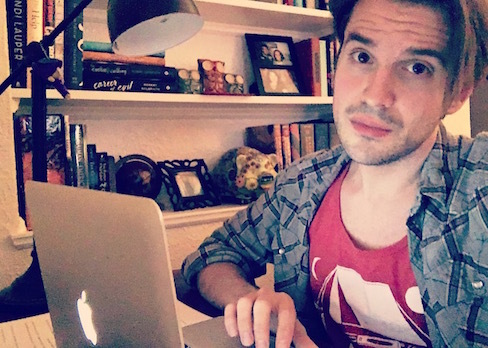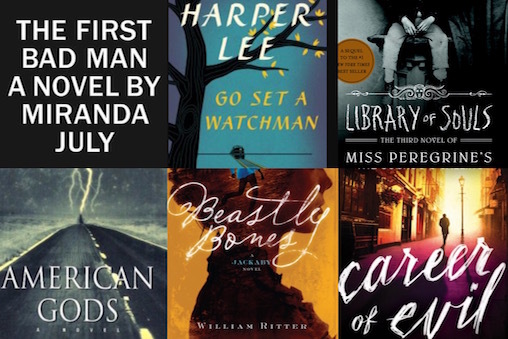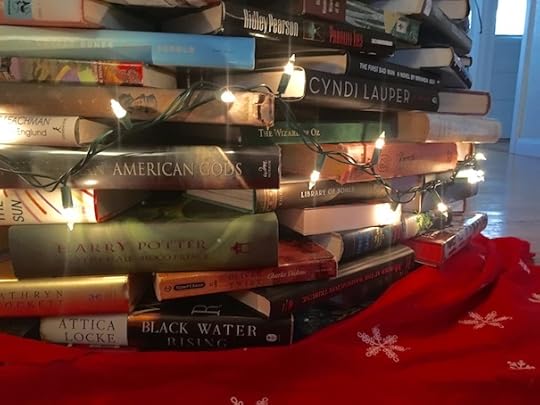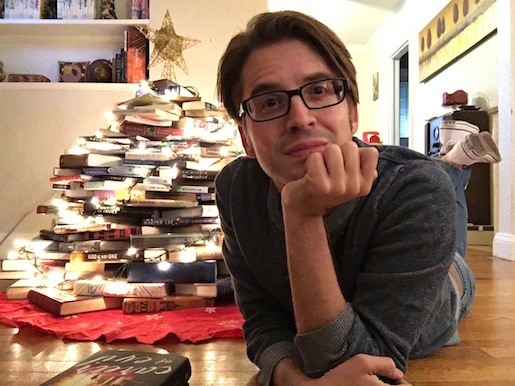Matthew Aaron Browning's Blog, page 3
November 11, 2016
My Family Voted for Trump: Searching for Understanding Amid the Fear
Several members of my family and friends supported Donald Trump in the presidential election. I’ve been trying to understand why, while grappling with the fear of an uncertain future.
Fear is a familiar concept to any marginalized group. As a member of the LGBTQ community, I’ve experienced it all throughout my life. And in the wake of this historic presidential election, I’m feeling fear that I never hoped I would have to face again and fear that I’ve never quite faced before.
I didn’t realize just how rooted in fear my life has been until I began trying to process my feelings after Donald Trump became the President-Elect. I come from a small coal town in West Virginia – a state that has become thoroughly red. And while I love that little town and the people in it, fear entered my consciousness early and stayed there. As a kid just discovering the concept of sexuality, I feared the attractions I was having, because what I was feeling was different than what I believed I was supposed to feel. I feared allowing myself to be okay with those feelings, because that would make me different…wrong…an abomination. I feared someone figuring out that I was different, even if I wasn’t yet admitting that I was. I feared the schoolyard bullies who figured it out anyway. Eventually, when I did allow myself to be okay with being gay, I feared coming out. I feared losing my family and friends. I feared being a disappointment to my parents. I feared that someone in that little town might hurt me because I was different.
Each time I faced one of those fears, I realized how unfounded they were. I had become so worried about imagined negative outcomes that I failed to consider any other option. Or maybe I just didn’t believe any other option was possible. But with time and experience, I learned that those feelings I felt were okay, that being different could be a beautiful thing, that my family and friends loved me, that my parents are proud of me, and that the people in that town had more acceptance in their hearts than I'd given them credit for.
The fear subsided the older I got and the more progressive and accepting society became. I began to feel safe. Over the past eight years, I’ve seen an advancement in LGBTQ equality that I wasn’t sure I would ever see in my lifetime. I can now marry the person I love and feel secure in the legal binding of that vow. I can raise a family. I can have the same life that all my heterosexual friends and family have never had to fight for or live without.
Today, however, I find myself once again grappling with fear – a familiar yet quite different fear. Over the next four years, that safety and security could be taken away from me. Because for many of us, there’s still the very real fear that marriage isn’t a right – it’s a privilege. I don’t want to feel that way. I don’t want to fear that way. While I’m neither married nor a parent, many of my close gay friends are both and are currently distraught over the possibility that their marriages and families could be in danger. It isn’t an overreaction. It’s real, grounded fear.
That fear stems in part from partisan politics. It was going to surface if the Republican candidate for president was elected, no matter who it was. If Trump hadn’t been the Republican nominee – if a more rational choice had filled that slot on the ballot – I would still be feeling that fear. I would be fearful about the social progress we’ve made being reversed with a shift in political power. But that’s the familiar side of this fear. It’s the other side that is new and deeply unsettling. I worry that the American people have become so divided and so collectively fearful for so many different reasons that I don’t know how we begin to heal.
I don’t need to rehash all the horrifying things Trump said during his campaign – or the horrifying things he’s said and done for many years. That’s all well documented. The fact that those horrifying things propelled him to the most powerful position in the country says to me that our culture is very damaged. I fear that people are already seeing these disgusting actions and remarks as okay, as celebratory even, and are being empowered by them to spread hate and violence. Many Americans responded to Trump’s behavior by choosing to support him because of them. We’re seeing that in the many dangerous responses to his victory. My Facebook feed already has examples of homophobic and racist treatment of people in the name of President Trump. And it goes both ways. Many people against Trump are participating in violent protests and falsifying claims of violence in the name of his presidency, which only serves to worsen the damage and widen the divide.
I also fear the message this is sending our children, many of whom feel that they’re in danger simply because they are different. It’s already happening. And it’s scary. My teacher friends have talked about being unable to comfort minority students who worry that they’ll be targeted for violence or deportation. Another friend’s son, when waking up for school to hear that Trump won the election, said “Rest in Peace, America.” What message are we sending to our young people?
It’s been almost too much to process, but I knew that I had to, because it has happened. And because I have to find a way to be okay with the fact that so many people I love supported this vile man. Some members of my immediate family did not vote for Trump, and there’s solace in that for me. But others did, and I couldn’t understand why.
The immediate response when I saw someone I know express support for Trump was to unfriend or unfollow them on social media – to create a cocoon in which I am only exposed to views similar to my own. That’s the easy thing to do. But I love my friends and family, even those who believe differently than me. So as I struggled to comprehend how they could support someone that instills so much fear in me, and how I could continue to consider them part of my life, I decided not to run from them but to try and understand, especially as the holiday season approaches, when I’ll be back in that town, surrounded by people who feel so differently than me.
The easiest thing to do is to lump all Trump supporters into one category – to imagine them all as clones of Trump himself and assume they all harbor the same prejudices as does he. The difficult thing to do is empathize with them – to understand why, in spite of the character traits that frighten me (the racism, homophobia, xenophobia, misogyny, etc.), they saw and heard the same things and voted for him anyway. They condoned these behaviors. So Wednesday morning, while my fear and disappointment were raw and my emotions high, I began trying to understand by weeding through the posts of Trump supporters on my Facebook page. It was an eye-opening but helpful process.
I had to remember that we all lend our support to political candidates whose agenda aligns most closely with our personal beliefs and circumstances, which in turn shape our priorities, and we condition ourselves to ignore faults while clinging to the solutions we seek. A year ago, I was in a doctor's office waiting room in a rural community similar to my hometown where a group of people, including a woman whose husband was an unemployed coal miner, were discussing politics. In response to who she thought would make a good presidential candidate, this wife and mother, in her camouflage, ankle-length dress and blaze orange flip-flops, shakily said, "He scares me, but Donald Trump." I couldn't fathom her thought process. As I read through the many posts of my friends and relatives this week, the reasoning became evident – and while no less disagreeable and disheartening, at least somewhat more understood.
I realized these are people who feel so failed and forgotten by the current system that they chose to support Trump, in spite of those terrible comments and actions, simply because he spoke to their own fears with the solutions they hoped to hear. They’ve lost jobs, and Trump said he would create them. They lack health care and are dissatisfied with the Affordable Care Act, and Trump has vowed to repeal it. They want a coal resurgence, and Trump promised one. Particularly unsettling, some of them (not all, which is important to say) fear people who look and live differently than they do, and Trump promised to remove those people and keep them from entering the United States. I have to accept that their desire for these things, as flawed as I think some of them are, is as strong and guiding as is my desire to be treated equally as a citizen of this country and not have to live in fear anymore.
My rights to live, love, marry and raise a family just the same as anyone else are vital to me. Issues like the economy and health care are equally vital, obviously, and I educated myself on my chosen candidate’s plans regarding them, but in all honesty, they weren’t the driving factors behind my vote. At the moment, I do have a steady income and health insurance, so I don’t have to face daily the absence of those things. And I haven’t experienced, firsthand anyway, the ramifications of the poverty, unemployment, lack of health coverage and substance abuse problems that have emerged in my hometown in the wake of coal’s decline. I see it when I choose to return home, but I admittedly don’t do that very often. I think some people believe I do that because I’m, as folks might say, “above my raising.” It isn’t that. It’s that my life – my views, my interests, my goals – has never quite meshed with the way of life in such towns. It’s not about being better than. It’s about being different from. And often in small towns – in any town – “different from” is a very difficult thing to be.
But that statement brings me back to my original subject: fear. I do fear what could happen under Trump’s leadership, as did many of these same people under President Obama’s, I know. I also fear that the promises Trump made to sway people like those I’ve discussed here were nothing more than the propaganda of a carnival barker saying whatever lies were necessary to achieve his quest for power, because to think that a New York billionaire has the best interest of a West Virginia coal miner in mind just doesn’t compute for me. But I am also beginning to accept the fact that this has happened and that many people in my life helped us get here, for better or for worse, and understanding why they made that choice despite the harm I feel it could do not only me but our entire country and world. And at least that’s something.
Don’t misunderstand me. I’ve purposely used the word fear a lot here, but I’m not buckling under it. I’m just acknowledging it, so I can begin to move forward and work to help ensure that the progress we’ve made together isn’t undone. I’m still processing, as we all are doing. I also know this won’t last forever. That’s how our political system works. President Obama won with a message of change in 2008. He brought change that upset and mobilized enough people to not elect someone who would continue his agenda. In four or eight years, the same thing will happen again. This too shall pass. But what progress might be undone in the interim, and where will we be as a society when we get there?
To end where I began: those are things I fear.
November 5, 2016
NaNoWriMoLetsGo
I started my second book, Blades of Grass, in 2012 as a National Novel Writing Month project, that special time of year when aspiring writers pump themselves full of caffeine and attempt to crank out 50,000 words of a novel by Nov. 30. I succeeded in that endeavor and documented the process on the blog. After it was all over, I was both supportive and critical of the whole NaNoWriMo movement, sometimes even in the same post. And while I still stand by my thoughts – it’s a difficult way to write a novel, and you will likely end up with 40,000 words of crap and 10,000 words of something possibly salvageable – it also gets you writing whether you want to or not, and that’s something with which I still struggle. So I decided to toss my hat into the ring with my current project and give NaNoWriMo another go.
I’m sort of cheating. I began this book last year and put it aside, then picked it back up recently. So I’m not starting from scratch; I’m starting with 20,000 words in the can. I would love to add the requisite 50,000 words to my working tally. But, between you and me, if I can reach 50K by the end of November, I’m claiming it a victory. I doubt the NaNoWriMo folks will care. You don’t actually win anything when you “win,” other than the satisfaction of saying you won. Hell, I could say that without writing another word!
So based on my current total, the NaNo website tells me I need to write around 900 words a day to reach the 50K mark. I think I can handle that. And maybe, just maybe, I won’t have to dump 40K of them at the end.
But I probably will.
Good luck to the rest of you out there #NaNoWriMo’ing. Feel free to vent about your process and progress in the comments below.
June 26, 2016
Prolific and Diverse
"Learning to be prolific would be high on my list of the most valuable writing skills a professional writer can have." – Brent Hartinger
The quote above, which Brent Hartinger recently made on his Facebook page, landed in my newsfeed at the most convenient time – a time when I was yet again questioning my future as a writer. As I’ve documented plenty of times on the blog, my journey has been stalled by rejection after rejection, even after signing with a reputable and successful agent. (That gets you further into the publisher’s door, not necessarily a seat at the table right away.)
So while I waited (and waited and waited) for my first novel to sell, I wrote a second one. While I waited for the second one to sell, I wrote a third. While I waited for the third one to sell, I started several more. As usual, I was doing quite well with those stories before eventually hitting a wall and taking a step back. Some of those stories have remained unfinished manuscripts, which I’ve also talked about here.
This spring, I was floundering a bit. I’ve never doubted that I would succeed at this writing thing eventually, and I don’t mean that in an egotistical way; more in a way that I’ve never felt more content than when I’m writing, so I’ve taken that to mean it’s what I’m destined to do.
Anyway, I say all that to say all this: Brent’s words about being prolific hit home. I could’ve stopped after that first book (or second or third) and just waited around for them to eventually land in the right editor’s lap. But I don’t want to do that. I cannot do that. Those books may never sell, or they may all sell. But I still have stories to tell. Different stories, to boot.
My first three books are all Young Adult fiction, a little ironic since I hated being a teenager. But I feel at home in that genre for whatever reason. Home, though, isn’t a place we should always stay. So to combat my most recent dry spell, I’ve begun venturing out. My most recent unfinished manuscript is a contemporary fiction piece instead of YA. And it’s an unfinished book that I surely hope to complete.
Meanwhile, in a true departure, I have just completed something brand new and very exciting: a children’s picture book manuscript. I’ll share more about it soon, but there’s a little on my Books page already. It was something very new for me but loads of fun to write – a story that I feel is an important lesson and – I’m told – a gap that is needing filled in children’s literature. We’ll see.
So I echo Brent’s advice about being prolific and offer this in addition: Be diverse.
March 2, 2016
Reflecting on the West Virginia Legislative Session
I typically only use this blog to share my journey as an author. I’m going off topic to discuss recent political events transpiring during the legislative session in my home state of West Virginia.
I’ve never been one to follow politics too deeply. I’ve kept up enough to know for whom I want to vote, but I lean rather far to the left in my values and beliefs so that’s never been a difficult decision. With this legislative session, however, I’ve paid close attention, and it has been a largely disappointing and worrisome process.
Topping that list of disappointments was House Bill 4012, the Religious Freedom Restoration Act, which passed the House of Delegates by a wide margin in February. Called a "license to discriminate" by opponents, you can read a little about why this piece of legislation was viewed by many, like myself, as dangerous and unnecessary in this post. The very name confounds me. Why seek to restore something that is already a guaranteed right? An example of a right that isn’t guaranteed is my right in this state to rent an apartment or keep a job without fear of eviction or termination simply because I’m a gay man.
Anyway, I love West Virginia. I was born here, and while I’ve moved around a bit, I’ve always lived within the state’s borders. I won’t necessarily stay forever, but I’m content right now. I have, though, questioned that statement a lot lately as I’ve watched legislation like HB 4012 progress.
Do I want to live in a state whose lawmakers seem intent on setting us back years in terms of civil rights, especially when we’re arguably already behind the times as it is? The easy solution is to leave, as so many have done and will continue to do. We’ve even reached a point where a new campaign is asking people to discuss #theStruggletoStay in West Virginia. I think that discussion is extremely important, but I’m sad we’ve arrived at a place where we need to have it.
I don’t blame people for leaving or wanting to leave. As I said, I’ve entertained those thoughts as well and am not so rooted here that I wouldn’t leave if the right opportunity presented itself. But I’d be running toward that opportunity, not merely running away from a problem. I think there is something to be said for staying put and helping to move the state toward a better future.
Plenty of people are doing that. From small businesses to large corporations and universities, the vocal opposition to HB 4012 swelled quickly. I watched eagerly as businesses all over the state showed their opposition through the All Kinds Are Welcome Here campaign, smiling when a coffee shop in my small hometown proudly displayed the campaign sticker on their storefront. I attended a “Books Not Bigotry” event in opposition to the bill at a local bookstore (one of several such events that have taken or are taking place surrounding this issue). And there are sitting legislators and up-and-coming candidates who are vocal in their push for equality in West Virginia.
So good things are happening. As I was leaving to attend the event at the bookstore, I learned that HB 4012 officially died in the Senate. A sign that all hope is not lost. A victory. A battle won. I hate to use the word “battle” here, but I will. A battleground does seem to accurately describe our state’s political arena. Or perhaps I should say “our nation” instead of “our state.” But don’t get me started on the circus that is the presidential race. That’s another post altogether.
The demise of HB 4012 is a bright spot on what has been a bleak canvas this session, and I’m very happy about it. And to end on a brighter note, I researched the voting results on HB 4012 when it first cleared the House of Delegates. One of my district’s Republican legislators also happens to be one of my health care providers. I was admittedly curious to know his vote on this bill that could’ve been quite damaging to me and so many people I care about. I’m not saying I’d switch doctors if his vote disagreed with my stance, but I did feel a little like Elaine Benes in the Seinfeld clip below.
He was one of few Republicans to vote against it. Gotta say, that made me smile.
February 18, 2016
STREAM: Reading Runs Through It
“How has reading flowed through your life and enhanced your education and career,” asks Read Aloud West Virginia in their new S.T.R.E.A.M.: Reading Runs Through It awareness campaign. Here’s #mySTREAMstory.
I spent a lot of time alone as a kid, with my nose in a book. Not because there wasn’t a loving family around me. I think it was partly by choice and partly by circumstance. I was the youngest of three children, and there was a decent-sized gap between each of us. My brother is four years older than me, and my sister nearly eleven. She was married and out of the house by the time I was eight. So we weren’t exactly peers.
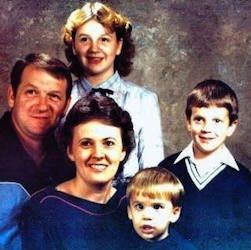 I was also what we used to call a latchkey kid. Dad was a sergeant with the Division of Natural Resources. Mom worked in medical offices. So I was usually on my own for a while after school. (I’ll add that they never failed to come home and prepare a hot meal for us, something of which I didn't realize the magnitude at the time. I used to get excited on the rare occasions we’d order takeout. Now at 35, I’m excited on the rare occasions I actually come home from work and cook. But I digress.)
I was also what we used to call a latchkey kid. Dad was a sergeant with the Division of Natural Resources. Mom worked in medical offices. So I was usually on my own for a while after school. (I’ll add that they never failed to come home and prepare a hot meal for us, something of which I didn't realize the magnitude at the time. I used to get excited on the rare occasions we’d order takeout. Now at 35, I’m excited on the rare occasions I actually come home from work and cook. But I digress.)
I wasn’t much into sports. My brother did the basketball and baseball thing. I’d sit in the stands with a book. I blamed my disinterest in athletics on a lazy eye and a lack of depth perception, but I think I just sucked at them. And I wasn’t into hunting, the other popular Browning family pastime. With a father in the DNR, you tend to be surrounded by hunting. Guns and bows and venison and squirrel gravy were everywhere, but I wanted no part of that. (I did go hunting once. I unwittingly made lots of noise, and they never took me again.)
I tell you all this to illustrate how and why reading has flowed through my life from early childhood. Books became my escape from the walls of my bedroom and from the mountains that fenced me into that little hollow. I may not have connected with my father in a tree stand, but I vividly remember him reading aloud to me stories like the Little Golden Books version of The Wizard of Oz or A.A. Milne’s poem Puppy and I. I couldn’t get enough of those two.
That early exposure developed a love of reading that has never faded. I was the kid who read for pleasure, not just by assignment. I remember my brother being assigned To Kill a Mockingbird for class and asking me if I’d read it. (I had.) And I was blessed with a string of teachers throughout my education that valued reading aloud during class, even well into high school. “How about a little Harris and Me?” Ms. Baisden would ask our 11th grade English class before launching into a chapter. (I have no recollection of what Harris and Me is about, but I can hear her asking us that question as if she were standing beside me.)
I guess with all that reading I was doing, and the reading aloud that was going on around me, I was destined to become a writer. And also destined to help spread the word about the importance of reading. That’s why I’m thrilled to tell you about an organization like Read Aloud West Virginia and their S.T.R.E.A.M.: Reading Runs Through It campaign. Studies show that children from homes with lots of books score up to 33 percent higher on tests than their peers from homes with few books. That’s just one statistic, though. They have plenty. And the literacy stats in West Virginia alone are eye-opening and often alarming.
So to learn more about the S.T.R.E.A.M. campaign (and, if you’re local, to grab a ticket to the upcoming Read-A-Palooza fundraiser happening in March), please visit the Read Aloud West Virginia website.
January 28, 2016
The Unfinished Manuscript
"I won't leave any unfinished manuscripts." – Harold Robbins
(Good for you, Harold. I can't make such a bold statement.)
Question for writers: How many unfinished books are collecting digital dust in your computer's filing cabinet?
There’s a folder on my desktop called Writing. Within that folder are several additional folders for each of the projects I’ve worked on over the years – novels, screenplays, short fiction, poetry. There are outlines, character biographies, and of course the manuscripts themselves. Some of them are finished. Some are perhaps a chapter or two long – seeds of ideas that broke the surface but didn’t quite reach full bloom. Well, not yet at least.
This week, I added another folder to that latter category.
Late last fall I began fleshing out an idea that appeared to be unique. I put out feelers to Agent Steve and a few writer pals for suggested books written in the same manner as my idea. I wanted to see how others pulled it off. Oddly, no one could think of any examples. The prospect of stumbling across something original (which isn’t as easy as it sounds) intrigued me. So I plowed ahead with the idea and, by January, was hovering around the 11,000-word mark. Then I hit the proverbial wall. I couldn’t make progress.
The reasons why weren’t all that mysterious. I hadn’t fleshed out the story and the characters enough to sustain it past that initial surge out of the gate. That’s pretty much what happened with all those unfinished projects. (Not that there are many. Maybe I shouldn’t say “all those.” There are, like, a few.) I try not to over-outline and get so excited about actually writing the story that I don’t plan my route far enough ahead, eventually getting totally lost and unable to move forward. So that’s where I was with this latest project, and it's a lousy feeling.
Suddenly, I got smacked in the face with a really cool idea for a different book. And I mean different in more ways than one. So far, every project of mine has landed somewhere in the Young Adult genre. This one isn’t. So that’s something I’m excited – and admittedly a little nervous – about. I've spent the past week and half using every bit of my writing time working on this new idea: sketching, outlining, researching, then diving hard and fast into the story this week. I’ve written 3,300 words in 24 hours and am (insert major wood knock here) having more fun with this than any of my other projects. This one is also requiring a little more research than my usual YA rom-com fare. So perhaps balancing the research with the writing surge will allow me to sustain this one all the way to the finish line. Is there a chance this idea could end up like the previous one? Sure. But I'll cross that bridge if I get there. (Or not.)
So, as for that book I shelved, I do hope to finish it eventually. I liked the characters and was enjoying getting to know them. They’ll be there when I get back to them.
Back to my original question: am I alone in this tendency to start and stop books? How many unfinished manuscripts do you have?
(Update: I just counted. I have four folders for unfinished novels, ranging from one that never got past the idea-sketching phase to that 11K-word project I discusssed above. Is that a lot??)
January 10, 2016
Writing Actually is Rewriting
You've heard it a thousand times: "writing is rewriting." Yawn! But actually, it's so true that it's punch-you-in-the-gut frustrating.
I’ve documented the writing process of my first manuscript, Welcome to Straightville, ever since I started this website, and it’s a process that is still in motion.
In a nutshell, I started writing the book during a semester break in graduate school back in 2008. I worked on it slowly over the next few years before I decided that a writer is what I wanted to be when I grew up and finished a workable draft in 2011. I started submitting it to agents that fall and, after a whole lot of rejection, eventually signed with Stephan Fraser at the Jennifer De Chiara Literary Agency the following year. I assumed Straightville would be available at your local bookstore shortly afterward.
Yeah…that didn’t happen.
The book went on submission and got plenty of good feedback that always had a “but” at the end of the response. “I like this, this and this, but here’s why I’m passing.” This happened a lot. It was around this time that I developed an appreciation of good red wine. Coincidence? Hmm… Also, I began to fear that the story I was telling would become dated. It’s a sweet love story and a coming-out tale set in a place where, well, you just don’t do that. But we’ve made some wonderful advances in equality since I wrote this book. Did the world need another book about a kid struggling with acceptance of himself? Were we past that as readers? The answer is of course "no, we aren’t!" It’s still tough. There are still people struggling, fighting, hating themselves…killing themselves. Any book that can show that struggle in a positive light is always going to be necessary.
Meanwhile, the rejections led to all kinds of great feedback from editors that helped me make the manuscript better. Steve would send it out to a few folks, we’d wait on that to trickle in, and I’d work the feedback into the book.
Time kept passing and I kept writing. I have since written two more books all the while tweaking Straightville from time to time. I attempted to be open about how it feels when your book doesn’t sell and focused on whatever new project I had at hand as Straightville lingered. Secretly, though, it’s always been my favorite of the books I’ve written, so I’ve never intended to give up on it. And it has gotten better. In fact, last summer I arrived at what I thought was the best version of it. We had another project on submission, so the new-and-improved manuscript hadn’t gotten out there yet.
Meanwhile, I started a brand new project late last year that I’ve kept busy with through the holidays. I hit the inevitable wall with it and had to step away, deciding to give Straightville another read while I shook off the struggle on the new book. It’s funny being a writer and creating these worlds. I’d been so engulfed in other projects since finishing that last revision that, as I reread it, I was excited to see what happened to these characters. I’d forgotten some of the changes I’d made. That’s always fun.
I edited as I went, fleshing out some weak scenes, punching up some dialogue, fixing typos. And I’ve arrived – yet again – at a new version of Welcome to Straightville that I hope to get into submission soon. It’s so very different from that version I queried with a few years ago, and I’ve fallen in love with it again.
As I said, I’m not giving up on this book. I adore these characters and the world they exist in. I look forward to seeing where this book ends up next and to the day I can finally welcome all of you to Straightville.
January 7, 2016
Favorite Books I Read Last Year
Ugh. Here we are well into January, and I never posted my list of the best books I read in 2015! You’ll notice only a few of these were actually released during that year. I don’t often stick to the New Releases list when choosing books. #sorrynotsorry
I immersed myself in Neil Gaiman in 2015, leading up to his appearance at the resurrected West Virginia Book Festival in the fall. I started with Stardust, then American Gods, then Good Omens, then began the journey that is Sandman (a journey I’m still on, btw). I also got a signed copy of The Sleeper and the Spindle at the book festival – a beautifully written and beautifully illustrated gem. Please don’t ask me to rank all these books. Gaiman seems able to tackle just about any genre he attempts, and I enjoyed each of the books listed here. I’ve got a few more titles waiting patiently on my shelf.
I also accomplished in 2015 a goal that I had undertaken back in 2014, or perhaps even 2013. And that was reading all the Song of Ice and Fire novels with which George R.R. Martin has yet to grace us. I devoured the first three books in the series before taking a lengthy break, trudged through the fourth book over several months, wondered whether or not I even had it in me to read A Dance With Dragons, and finally buckled down and finished it over the summer. I will say that the fifth book is superior to the fourth, but boy were the both of them a chore.
The First Bad Man by Miranda July was a beautifully bizarre book by a beautifully bizarre writer. Her short story collection, No One Belongs Here More Than You, is a charmer and a favorite. She’s done film and music work as well. I’m looking forward to seeing what she comes up with next.
Ransom Riggs unleashed the third book in the Miss Peregrine series, Library of Souls. The first book, as first books often do, remains my favorite of the three, but I thought this a nice ride. I was turning pages.
In what’s becoming another favorite series of mine, William Ritter gave us a second Jackaby novel in Beastly Bones. Called a mix between Sherlock and Dr. Who, Jackaby is a fun and unique character that I look forward to learning more about. The second outing didn’t capture me quite as strongly as the first, but a pleasure nonetheless.
Apparently J.K. Rowling really enjoyed writing her latest Cormoran Strike novel, Career of Evil, the detective series she writes under the penname Robert Galbraith. I’ll certainly say, however, that it wasn’t the most enjoyable of her books to read. This one took me a while to finish. I like the characters and the world Rowling has built around them, and the last novel in this series was great. This one just didn’t thrill me like the others have. But I’ll scoop up the next one and dive right back in, I’m sure.
And finally, we have Harper Lee’s Go Set a Watchman. Was this a good book? Let’s be honest. No, not in the conventional sense. But that’s okay, because it was never meant to be. It’s an early draft of a manuscript that eventually, after much revision and reimagining, became a classic. I found it a fascinating glimpse into the writer’s process.
November 15, 2015
How to Build a Book Tree, Part Deux
In my last post, I provided a step-by-step guide to building a book tree for the holidays. I approached the project with limited research and a limited number of books, ending up with a rather small tree that, while cute, was just a little too little for my liking. If Charlie Brown had built a book tree for the Christmas play, it would've looked a little something like mine.
Okay, maybe it wasn't that bad. But after staring at the little tree for a day, I figured there had to be a way to get a taller tree without loading up on more books from the local Goodwill.
 Then, while doing laundry in the basement, I had an epiphany. Or, rather, a half-baked idea. But epiphany sounds more climactic.
Then, while doing laundry in the basement, I had an epiphany. Or, rather, a half-baked idea. But epiphany sounds more climactic.
I dusted off an old U-shaped end table and hauled it up to the living room, deciding it would make the perfect hidden shell for a taller tree. I disassembled the little tree, slid the end table against the wall and began building the tree around it. I needed fewer books because I wasn't going in a complete circle this time. And the table provided excellent reinforcement as the layers increased. Meanwhile, while in the basement, I did dig up some more books that I'd forgotten about. Not a lot, but enough to just about double the size of the tree I'd built before. The first tree wasn't quite as tall as my waist. The new one comes almost to my chest. And I'm 5'9". You do the math.
So while the process I described in my previous post is still on the money, if you have a limited number of books but still want some height, find something like an end table to build around. And make your books go further by building against a wall, eliminating the need for a complete circle.
Once again, Happy Holidays!
November 14, 2015
How to Build a Book Tree
I'm a holiday decor minimalist. I haven't put up a Christmas tree since adopting pets (because I learned the hard way that cats and Christmas trees don't mix). Instead, I've opted for a novelty Charlie Brown tree and some garland around my fireplace mantel. But I was recently at Cathedral Cafe, a charming little eatery in Fayetteville, W.Va., and was quite taken with their giant book tree. Despite the fact that it's mid-November, I raced home to give it a try myself.
There are already plenty of how-to guides online for making a book tree. Some suggest using boxes or small tables in the middle. Some don't. Some trees are small and some are the size of actual Christmas trees. I wasn't sure how much space I would need, how many books I would need, how decorative I'd want to get. Basically, I knew nothing, which is often a great way to start a project. So I decided to document my process for those of you who don't want to do a lot of research, but just want a cool holiday decor alternative. Here goes.
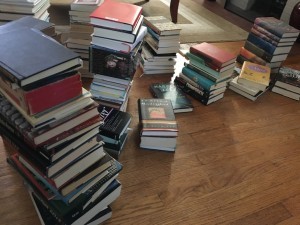 Bring all your books to the living room (or wherever you want your tree), away from where you plan to build. I had no idea how many books I have and how tall a tree they would make. For a writer (and writers are supposed to be quite well read, mind you), I don't own a ton of books. But I hauled most of them downstairs and piled them up. I add the "away from where you plan to build" part because I did not do this, and it got quite cluttered around my workspace.
Bring all your books to the living room (or wherever you want your tree), away from where you plan to build. I had no idea how many books I have and how tall a tree they would make. For a writer (and writers are supposed to be quite well read, mind you), I don't own a ton of books. But I hauled most of them downstairs and piled them up. I add the "away from where you plan to build" part because I did not do this, and it got quite cluttered around my workspace. Sort the books by size and style. This is dull work, but it helped. Large hardbacks in a pile, small hardbacks in another pile, large paperbacks in a pile…you get the idea. This came in quite handy when needing to fill tiny gaps for balance, which we'll get to soon.
Choose a space and create the base of your tree. The size of the space you've got to work with will determine the girth of your tree. Make the base as big as the space will allow by forming a circle with your heaviest hardback books, spines facing outward. I placed a couple big books in the center of the circle mostly to get them out of the way and figuring it could help make the middle a little sturdier. I then placed an empty box in the center to add more stability as the stack grew.
Build your tree layer by layer like a pyramid, using the heavier books first and working your way toward the lighter, smaller books as you progress. Each layer will rely on the layer under it for support. The trick to getting the treelike look is not stacking each book directly atop the one below it, but to stack a book atop the two books beneath it so that the ends of the book are resting on each of the two books below it, and there's a bit of a gap in the center of the book. Continue building in this manner.
As you build, you'll inevitably need to fill gaps caused by books of varying thickness. Use the smallest of your paperbacks or thin hardbacks to help even things out as needed. This is where the sorted book stacks come in handy. You'll know just where to find those small books without much digging.
Eventually, your layers will reach the top of your center box and start closing in around it as you near your tree top. Use the boxtop as a base of sorts and stack books directly on it at this point, using the same layering method as you have all along. Soon, you'll come to the top of your pyramid and can place your last book to top your tree.
Decorate! As I said, I'm a minimalist. I wanted to be able to read the spines of the books so I simply used a string of white lights and a star to top the tree. But be as creative as you would with a real tree – garland, ornaments, the whole shebang.
Here's a little video I made of the process.
Some Additional Tips:
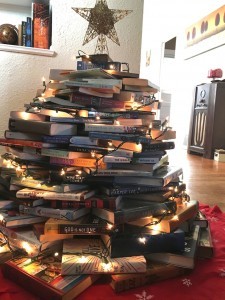 Not sure how many books you'll need? I wasn't either. Just use what you've got and see what you end up with. I didn't count my books beforehand, but I ended up with a just-below-waist-high tree. I'd love to have a full-size one! I guess I've got some more reading to do.
Not sure how many books you'll need? I wasn't either. Just use what you've got and see what you end up with. I didn't count my books beforehand, but I ended up with a just-below-waist-high tree. I'd love to have a full-size one! I guess I've got some more reading to do.Convinced you don't have enough books? Been downloading too much stuff on that Kindle? If you don't mind spending a little money, check out thrift stores, libraries, used book sales, etc., and stock up on cheap books. Or ask your friends to borrow some of theirs. [Attention my friends: please don't ask this of me. I hate loaning out books. They never seem to return!]
Put your favorite books in the front. Visitors will likely check out the books in your tree, so put those old books you can't even believe you own (or those thrift store finds) in the back, against the wall.
Never leave your tree lights on unattended. Paper is flammable, you know.
Don't use any books you intend to read before the end of the holiday season. I accidentally put my copy of Career of Evil, the latest Cormoran Strike novel, into the tree and had to very carefully remove it, Jenga style.
All in all, I'm pleased with my experiment. It could've been a little tidier. It could've been a little bigger. But it's certainly adorable.
Happy Holidays!







